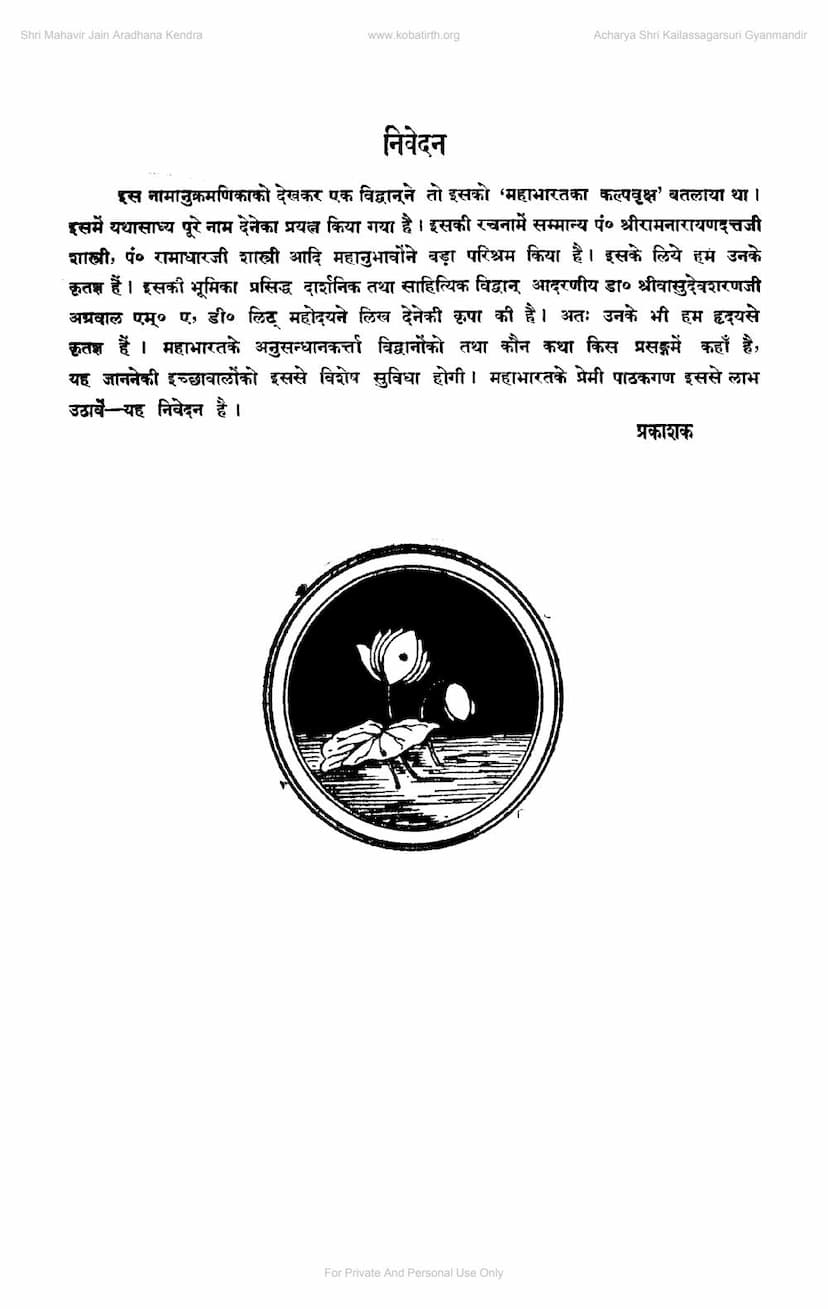Mahabharat Ki Namanukramanika Parichay Sahit
Added to library: September 2, 2025

Summary
This Jain text is a Mahabharat Ki Namanukramanika Parichay Sahit, authored by Vasudevsharan Agarwal. It's a comprehensive index or concordance to the Mahabharata, providing a guide to its characters, places, and concepts, along with brief introductions.
Here's a summary of the key points based on the provided pages:
Purpose and Significance:
- "The Kalpavriksha of the Mahabharata": The index is described by a scholar as the "Kalpavriksha" (wish-fulfilling tree) of the Mahabharata, highlighting its extensive coverage and usefulness.
- Aid for Researchers and Enthusiasts: Its primary purpose is to provide significant convenience for Mahabharata researchers and anyone wishing to know the context and location of specific stories or events within the epic.
- Promoting Deeper Understanding: The publication aims to encourage a more profound study and appreciation of the Mahabharata by making its related literature more accessible.
- Part of a Broader Movement: It's seen as a contribution to a larger movement focused on the revival, interpretation, and propagation of Indian culture, with a particular emphasis on the Mahabharata.
Content and Features:
- Extensive Name Index: The core of the work is an exhaustive index of personal and place names found in the Mahabharata.
- Brief Introductions/Identifications: Each entry provides a concise identification or introduction to the name, offering context.
- Location References: The index clearly indicates the Parva (section), Adhyaya (chapter), and Shloka (verse) where each name is mentioned, allowing for easy retrieval.
- Unprecedented Utility: The publishers acknowledge that such a useful index in Hindi or any other Indian language had not been published before.
- Inspiration from Sorensen: The compilation of this index drew inspiration, at least partially, from the style of "An Index to the Names in the Mahabharata" by Dr. S. Sorensen, a Danish scholar, published in 1902. However, Sorensen's work is noted as being rare and expensive, making this accessible publication particularly welcome.
The Author and Contributors:
- Author: Vasudevsharan Agarwal, a renowned philosopher and literary scholar, wrote the introduction (Bhumika).
- Contributors: The index itself was compiled with significant effort by esteemed scholars like Pt. Shriramnarayan Dattaji Shastri and Pt. Ramadharji Shastri, to whom the publishers express their gratitude.
Thematic and Philosophical Insights (from the Introduction):
- Mahabharata as a Repository: Vasudevsharan Agarwal emphasizes that the "hundred-thousand-syllable Mahabharata" is an inexhaustible treasure trove of Indian knowledge, dharma, artha, kama, and culture.
- Balance of Purusharthas: The text highlights how Krishna Dwaipayana Vyasa, using the story of the Kurus and Pandavas, presented dharma, artha, kama, and moksha in a balanced way, where each aspect supports and complements the others.
- Mahabharata as a "Maha Shastra": It's described as a great scripture that can be used to extract the essence of various other disciplines. It's considered a superior dharmashastra, the ultimate artha-samuccaya, a leading kamashastra, and the best moksha-shastra.
- Depiction of Ashrama Life: The text portrays the dharma of all four ashramas (stages of life), which helps in establishing good conduct, social order, and maintaining caste purity.
- Vyasa's Liberal Perspective: Vyasa's thinking is characterized as exceptionally liberal, making the Mahabharata a "Maha Shastra" free from any possibility of conflict.
- Influence of Vedic Knowledge: Vyasa's words are seen as a great stream of knowledge flowing from the high peaks of Vedic wisdom, cleansing the world of the impurities generated by Rajas.
- Refutation of False Logic: The text states that false logic cannot stand before the impactful discourse of Vyasa.
- Mahabharata as a Sacred Lake: It's likened to a deep lake of Vedic knowledge, filled with the vast narrative of the Kurus and Pandavas, where various lotus blooms of Vedic and worldly stories are found. The sweet sounds of swans playing in this water are compared to the beautiful vocabulary of the Mahabharata.
- Lord Krishna and the Mahabharata: It mentions that Krishna Dwaipayana Vyasa revealed his world-purifying form through the Mahabharata.
- Vishnu as the Supreme Analogy: Vyasa is compared to Lord Vishnu as a divine Kalpavriksha, with dharma as its root, Vedas as its trunk, Puranas as its branches, sacrifices as its flowers, and moksha as its fruit.
- Mahabharata as a National Corpus: It's considered the ancient national corpus of India, containing the essence of meaning revealed in the eyes of ancient sages.
Key Themes and Content in the Introduction:
The introduction delves into the profound philosophical and literary significance of the Mahabharata, describing it as a repository of knowledge, dharma, artha, kama, and moksha. It highlights the balanced presentation of these human pursuits within the epic, facilitated by Vyasa's liberal and comprehensive vision. The text also emphasizes the Mahabharata's connection to Vedic knowledge and its role in purifying the world from the "impurities" of Rajas. Furthermore, it touches upon the philosophical discussions present in the epic, such as the debates between fatalism (daivavada) and determinism (purusharthavada), highlighting the intellectual depth of the text. The introduction also praises the Geeta Press edition for its inclusive name index and hopes for the publication of ancient commentaries on the Mahabharata. It notes the diverse philosophical viewpoints like kalavada, swabhavavada, niyativada, yadrichchhavada, bhutavada, and yonivada that are explored in the epic, particularly in the Shanti Parva. The mention of Mankhi Rishi's viewpoint, possibly linking to Mankhaliputta Golasala in Jain tradition, indicates a broad engagement with various philosophical schools.
Overall, this work is presented as an indispensable tool for anyone seeking to navigate and understand the vast and complex world of the Mahabharata.